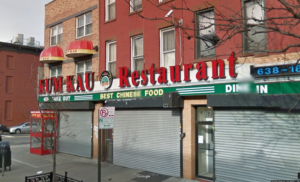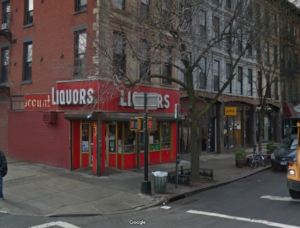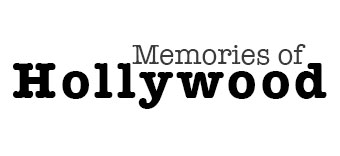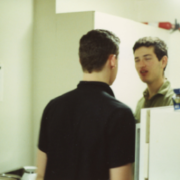I was feeling a bit nostalgic the other day, so I did what I usually do when the pang strikes. I looked up Google Street View’s visuals of the modern versions of my nostalgic targets. Sometimes it really helps when I do this; it helps me remember more detail, especially when (as in this case) there have not been too many changes. But please don’t tell that to the people who live around 21st Century Myrtle Avenue in Brooklyn, they think everything is different, particularly between Clinton and Classon Avenues, the part of the Avenue that borders Pratt Institute. It seems people who’ve lived adjacent to Myrtle and would know have always tended to move along after a while but the news sites and blogs say there is a new Brooklyn. I looked at Google to see how much I could remember.
The strongest long term memories any person can draw upon are the ones that are either markers of dramatic life events (for good or ill) or are ones that in any way tend to stoke the ego. As you’ll come to understand, these latter ones can also be for reasons good or for ill. When it comes to what constitutes ‘ill,’ I guess that is just subjective.
The Google images are from January 2013, and as you use your mouse to ‘drive’ up and down the Avenue, the sky is overcast; buildings, sidewalks and people are cast in shades of grey. The very few trees that exist are bare, their branches seem to be desperately striving to reach up, to maybe pull themselves out of their moorings and head for more colorful surroundings. Anywhere but on Murder Avenue. Murder Avenue, that’s what we called Myrtle back in 1987 and ’88. My fun Myrtle memories are from those two years; some darker ones I have are from the next three after that, those, in their own weird way, are the ego stokers.
As a student at Pratt, my entry point onto Myrtle was the little walkway north of my dorm building, through the gate that marked the temporary interruption of Grand Avenue. We students ventured out to get food or to pick up care packages from our parents at the post office. The P.O. and Associated Foods were to the left. Because of stories we had heard we tried to make our trips to Myrtle short and fast. Especially the kids like me, who were from outside of New York. Late Eighties Myrtle Avenue had an exotic vibe to it, like a place only the adventurous dared to visit. Crime was worse around there back then than it is today and we believed all the worst stories people had to share. It was hard to listen to people like my friends like Edese or Chris, who were native New Yorkers and who tried to get me to believe Myrtle was no better or worse than any major outer borough avenue. It was hard to believe these guys, especially when kids were getting mugged at the Classon Avenue G Train stop, or when, early in 1988 and on the DeKalb side of campus, a student was shot and killed because she wouldn’t give up her purse. On the heels of this, Pratt officials officially recommended that students carry what they called “mugging money,” a little cash meant to assuage any frustrated mugger. And belatedly they added, ‘please don’t resist, give up the purse, the wallet, the better to not piss off any future armed attacker.’
The surrounding campus avenues took on the cast of ‘the other,’ those streets and everything outside it was sometimes what was snidely referred to as ‘In Brooklyn,’ as if Pratt itself existed in some bubble that defied borough classification. But, I too hurried to and from Myrtle, concerned for my safety, especially if I had been awakened by gunfire the previous night. I quickly came to believe there were art students and there were Brooklynites, and they existed on opposite sides. It made me feel self-conscious every time I went out, like I was being assessed somehow and found wanting. This belief in ‘other’ can make a person generalize, it did me anyway, and I believed I lived in a bad neighborhood that was homogenous, not only ethnically, but in its opposition to everything Pratt. The first part of this assumption was mostly true but the second part most decidedly wasn’t. I realized later on that college students, and definitely college art students, then and now, are almost by definition, and I suppose by necessity, quite self-absorbed.
Looking at the Google Maps images of this part of Myrtle Avenue, I can tell you not a single thing has changed from 1987 until now, except obviously that T-Mobile store. The post office has not been updated or changed, it looks like not even repainted; and the big grocery store has the same red awning in front as it did back then. Ask any New Yorker though, they will tell you that Associated Grocery stores never change, they are in essence the negative interpretation of ‘timelessness.’ The streets and sidewalks are the same, having only been dirtied, then washed and scrubbed by thirty years of rain and snow.
Looking at the images and remembering, one might be fooled into thinking maybe everything was the same even decades before I was there, and maybe some of it was. I would have definitely thought so back then, when I was 21 years old. But way before my time there existed a big El Train that clattered its way noisily past there, down Myrtle Avenue and branching off around where MetroTech now sits to the west. That was thirty years before my time there and now we’re thirty years on from my own college days. I wonder what Pratt students back then were like. Did kids wear ties? Was the air a little dirtier from automobile and El train exhaust? And did 1950’s art students also think of the rest of Brooklyn as ‘other?’ I’d like to think not so for that last one, and I have some evidence, for after a few years living in Brooklyn I didn’t either.
The second thing I discovered on Myrtle, after the ready availability of food and postage stamps, was located at a quick right hand turn at the Grand Avenue gate, the beer and wine distributors. It was a low slung old building no taller than the post office. Situated right next to the gate, it was open really late and was an obvious favorite of Pratt students. It was seedy and dirty but it had beer, a lot of beer. Beer was good, for in my case it helped blur that made-up line between ‘us’ and ‘them.’ It helped me to relax. Always on the lookout for any sign that things on Myrtle were getting better, we Prattlers were excited to see a White Castle open up across the street from the distributors in late ’88. As of 2013 it was still there, but it looked as if it had the crap beat out of it over the years, suffering mightily from White Castle’s usual refusal to update its look. Back on the Pratt side, however, nowadays the distributors is long gone.
At some point in the last thirty years they tore the place down, I’ll bet students must have really mourned it. Now there is a five or six story building in its spot, anchored by a big Blick’s art supply store, a couple of other stores there too but no evident booze. Because I can’t look at it on Google now, I can’t really remember what the distributors used to look like, except for that metal shutter that sealed off the front door every frustrated Sunday. The tan color outside, the cavernous interior.
Further east on Myrtle, same side, is another new building, the Pratt Store. When I was a student the Pratt Store was a tiny business practically buried down a hallway from the PI Shop in the Main Building. Maybe the new store is the first gambit by Pratt to emulate NYU as Manhattan’s private college gobbles up every last part of the Washington Square area. Maybe Pratt will eventually take over that part of Myrtle going towards Bed-Stuy.
Kum Kau Restaurant was at the same spot on Myrtle Avenue then, but back then it was smaller. They expanded into the next storefront sometime in the early Nineties. There was another Chinese restaurant closer to Pratt on Myrtle called Dragon Garden. On its best day they only managed to draw off maybe 15% of Kum Kau’s student clientele. The kids who ate at Dragon Garden considered themselves to be some kind of connoisseurs because they refused the much more popular (and much better, to be honest) restaurant on the corner of Washington Avenue. Dragon Garden is gone now. Looking behind the restaurants, I only crossed over north from Myrtle Avenue once, and that was with my girlfriend to stop at a polling station and vote for Michael Dukakis. That whole time I had no idea that I lived about three blocks from the Navy Yard and the East River.
What I do remember of Myrtle Avenue from those days, the Tarzian Hardware (now gone) that was near Clinton Street, the smaller-then but still excellent Kum Kau Restaurant and the beer distributors; those were all part of my 1987 and ‘88 fun Myrtle memories, where I was a student and new New Yorker who was slowly learning to see myself as a local Brooklynite; and where I learned to break down homogenous perceptions about race and crime. I looked around a little bit more and I saw blacks, whites, Asians, Arabs, people of all types that lived in and around Myrtle Avenue. I saw that some former students hung on in the area too, at least for a couple of years. By 1989 I had stopped calling it ‘Murder’ Avenue. After I put down the sketch books and charcoals I realized that Myrtle Avenue had likely always been about diversity.
From 1989 forward any time I spent on Myrtle Avenue I spent as a ghost, haunting Kum Kau and the little liquor store catty corner (or kitty, if you prefer) from my favorite Chinese restaurant. By this time, I had moved into a share a couple of blocks south on Washington Avenue and was out of Pratt. Ashamed of my ex-student status, I shunned the Gates Avenue entrance and that whole part of Myrtle Avenue. Though that meant missing out on the beer distributors, well for me that was OK, for I had moved onto slightly harder stuff at the little red liquor store that, I swear to god, doesn’t look any different now in any way than it did when I was a denizen there thirty years ago. Even the ‘Discount’ part of the store sign was missing its D and I, as it is now.
It seemed beer had gotten boring for the most part and someone had told me about these new high powered wine coolers called Cisco. The red liquor store had them and thus they weren’t far from my apartment. Orange was my favorite flavor of these 40 proof beauts, and before long the clerk would just drop a couple on the counter as soon as I walked in the door. I wasn’t in school anymore – I didn’t have too much else to do, except get a real job and while away the extra hours, while contending with the icepick headaches the Ciscos sometimes gave me. Though my waking consciousness was often a hazy experience on Myrtle Avenue from 1989 to, say 1991 (when I had moved to another neighborhood), I have a strange nostalgia for those trips back and forth to the liquor store or to Kum Kau. Those are my darker Myrtle memories, the weird ego boosting memories I referred to earlier; back from those days when I was more ‘other’ than student. Even then it filled me with a bit of pride, as I admit it does now.
The way I explained it to people then, was that I was leaving the artificial construct of graphic and industrial design for a more realistic life of the everyday New Yorker. But, curiously, at other times I told people I was doing performance art. I guess it depended on my mood and my level of soused-ness. Either way, I felt like I had become someone grittier, as if I had more in common with Brooklynites around Myrtle, you know, the ones who didn’t go to Pratt. I lived off-campus, out of the bubble, Bed-Stuy do or die style. Having to work hard to pay my rent forced me to look at people and things around me more clearly, even as my actual vision was sometimes a little blurry.
I endured more grittiness after I moved to Park Slope, so my last memories of Myrtle Avenue are out of focus. But foggy or not, they crystallized just the same. Today this part of Brooklyn is considered gentrified, or ‘yuppified,’ as we would have called it then. There are a couple of tall office buildings not far away. They now have things like “pet spas,” “Starbucks” and “microbreweries.” Hillary Clinton even has her Presidential Headquarters at the end of Myrtle Avenue. There are more families in evidence as well. I wonder if any current Pratt students, maybe from Ohio or Florida (as I was), still call it Murder Avenue and think about ‘otherness.’ I hope not. But then again, I kind of hope they do; because there’s more to learn from a wrong attitude that changes than an attitude where one is seemingly always right. Pratt itself is also doing better, the student body is more diverse than it was thirty years ago, though I saw it as nicely diverse then too. But there’s something about the school, it now has the look of a place that is not raising tuition every year just to survive, as had been claimed then.
Many buildings have changed; many are the same. People have moved in and out many times over. I’m sure the professorial staff at Pratt has completely turned over in thirty years. Maybe there’s not even any more gun fire at night. So if you say Myrtle Avenue is different, I hear you. I see the changes that have taken place myself. But when I focus on certain spots, and when I try hard to remember different attitudes, it hasn’t changed a bit, nope, not at all.




